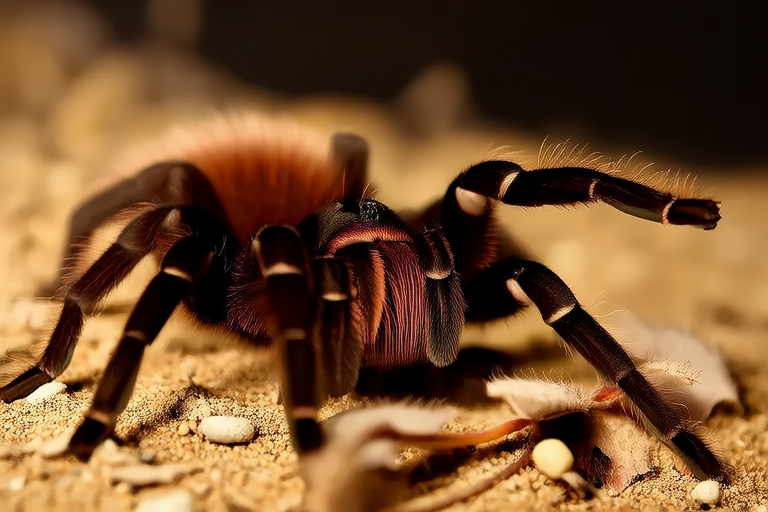The Ultimate Guide to Handling and Caring for Your Chilean Rose Tarantula
Welcome to the comprehensive guide that will help you become an expert in caring for your Chilean rose tarantula. This article covers everything from setting up their habitat to understanding their dietary needs and health concerns.
Introduction to Chilean Rose Tarantulas
The Grammostola rosea, commonly known as the Chilean rose tarantula, is one of the most popular species among tarantula enthusiasts due to its manageable size, docile temperament, and relatively simple care requirements. Native to South America, these spiders have a lifespan of about 8 to 15 years and grow to approximately 4 to 6 inches in length. Their coloration ranges from light pink to dark brown, with some individuals displaying vibrant colors.
Suitable Habitat Setup
Enclosure Size
For a single adult Chilean rose tarantula, a terrarium measuring at least 10 gallons (approximately 12 x 6 x 6 inches) is recommended. Juveniles can be housed in smaller enclosures but should be moved to larger tanks as they grow.
Substrate
Adequate substrate provides essential burrowing opportunities and helps maintain proper humidity levels within the enclosure. Optimal substrates include coconut fiber, peat moss, or a mixture of both. Avoid using wood chips or pine shavings, as they may cause respiratory issues. A layer thickness of around 3 to 4 inches ensures sufficient depth for burrowing.
Temperature and Humidity
Chilean rose tarantulas thrive in temperatures ranging between 75°F and 85°F (24°C – 29°C). Use a thermometer to monitor ambient air temperature and maintain it within this range. For humidity, aim for levels between 60% and 80%. Utilize a hygrometer to measure humidity accurately. Mist the enclosure lightly every few days to achieve the desired moisture level.
Lighting Requirements
These tarantulas are nocturnal creatures, so they do not require direct sunlight. However, providing a low-level UVB light source can benefit their overall health. Ensure that any lighting used does not emit excessive heat, which could disrupt the temperature balance inside the enclosure.
Appropriate Diet and Feeding Habits
Chilean rose tarantulas are carnivorous and feed primarily on live insects such as crickets, mealworms, and dubia roaches. Offer prey items no larger than half the width of the spider’s abdomen. Feed juveniles every 5 to 7 days, while adults can be fed once weekly. Always remove uneaten prey after 24 hours to prevent potential harm to your tarantula.
Handling Techniques and Safety Measures
When handling your Chilean rose tarantula, gently scoop it up using a broad, flat tool like a popsicle stick or a spoon. Support the entire body, avoiding contact with sensitive areas such as the legs and abdomen. Allow the spider to walk onto your hand rather than forcing it. Be cautious during handling sessions, especially if your tarantula exhibits defensive behavior by raising its front legs or flicking urticating hairs.
Common Health Issues and Signs of Illness
Regularly inspect your tarantula for signs of distress, including lethargy, refusal to eat, or abnormal leg movements. Common ailments include mites, fungal infections, and digestive problems. Consult a veterinarian specializing in exotic animals for diagnosis and treatment options. Early intervention is crucial for effective recovery.
Tips for Molting Care
Molting is a natural process where tarantulas shed their exoskeleton. To facilitate this event, increase humidity slightly before and during molting. Monitor the process closely without disturbing the spider. Once completed, ensure that the new exoskeleton hardens properly before resuming normal feeding schedules.
Breeding Considerations
If considering breeding Chilean rose tarantulas, ensure both sexes are mature and healthy. Provide separate enclosures until ready to introduce them for mating purposes. After successful copulation, females may produce egg sacs containing hundreds of eggs. Hatchlings require specialized care, including smaller enclosures and appropriately sized food items.
Advice on Social Interaction with Humans
While tarantulas do not form bonds with humans like mammals might, regular gentle handling can promote trust and reduce stress. Limit handling sessions to short durations to avoid overstimulation. Always wash hands thoroughly before and after interacting with your pet to prevent the spread of bacteria.
By following these guidelines, you’ll provide your Chilean rose tarantula with optimal living conditions and ensure its long-term well-being. Remember that each individual has unique preferences, so observe your pet closely to tailor its environment accordingly.
